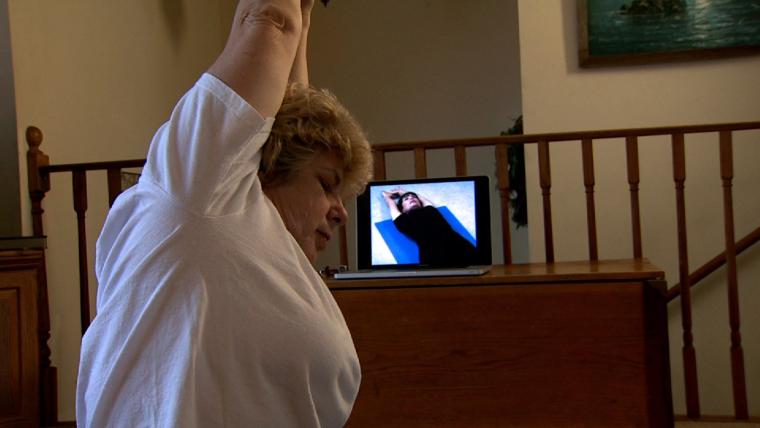Writer
Curt WohleberCOLUMBIA, Mo. – For some, the idea of yoga might conjure images of young and unusually flexible people folding themselves into human origami. But yoga has more to do with breathing—something everyone can do—than extreme postures, says Lynn Rossy, health psychologist for Healthy for Life, the University of Missouri System’s employee wellness program.
“If you’re alive, you can do yoga, even if it’s just sitting or standing and breathing deeply,” says Rossy, who teaches yoga as part of Healthy for Life programs on stress reduction and mindful eating.
While yoga emerged thousands of years ago from South Asian religious practices, in 21st-century America yoga is an increasingly popular way to improve mental and physical health. Yoga techniques have found their way into physical therapy and the training routines of some NBA and NFL athletes. Even in a time when many businesses are struggling, new yoga studios are appearing across the country.
Research suggests that yoga can help people with arthritis, high blood pressure, depression, asthma and other conditions. But people who practice yoga say the main reason people do it is it makes them feel good.
“It took me 50 years to discover an exercise I like,” says Diane Oerly, who began yoga several years ago through Rossy’s Mindfulness-Based Stress Reduction class. “If I miss doing yoga for awhile, my body kind of talks to me. My foot will hurt or something and I get motivated to keep up with my yoga.”
Oerly, who works for MU as a grant writer in the field of information technology, said she was impressed by the scientific research supporting the benefits of yoga in maintaining or improving mental and physical health—benefits she has personally experienced.
“My body doesn’t hurt like it used to,” she says. “A lot of times, if I had done something strenuous like painting the house, my body would be sore and achy. But if I do yoga, I can get through things like shoveling the driveway or raking leaves. If I stretch out, get my muscles relaxed, my body relaxed, I don’t suffer like I did before.”
At 56, Oerly also appreciates yoga’s role in improving her balance. “One of the things I’ve learned about balance is how very important it is not to fall as you get older.”
She says yoga also helps her achieve inner balance. “It helps you get out of your brain and come to terms with what’s really important.”
“It’s not mystical or magical,” Rossy says. Yoga helps people relax and can help them become stronger and more flexible—things that contribute a lot to health and well-being.
For example, yoga and other stress-reducing practices can lower the body’s level of cortisol, a hormone released under stress as part of the “fight or flight” response. Over time, the effects of elevated cortisol levels can contribute to a host of health problems throughout the body.
A yoga session typically starts with the practitioner taking slow, conscious breaths. “We run around way too fast, way too busy, and our breathing tends to become more and more shallow,” Rossy says. “That’s bad for the body and for the brain. When you get more oxygen into the body, it begins to function better.”
The movements and postures help loosen tense muscles while gradually building strength and flexibility. While some advanced postures can be challenging and perhaps hazardous for beginners, Rossy teaches a gentler style of yoga. “It’s not about putting your leg behind your head. It’s about bringing a slight to moderate sensation of stretch to the muscles of the body. And, ultimately, it’s about becoming present, which helps your mind to relax.”
Yoga’s burgeoning popularity has turned it into a multibillion-dollar industry, bringing in revenue from classes, books, videos, and yoga mats and other accessories. But you can benefit from yoga without spending a lot of money, Rossy says. You don’t need special shoes, or any shoes at all; it’s customary to practice yoga barefoot. Instructional books and videos are available from public libraries. Audio and video recordings are available for free online. The Healthy for Life website has downloadable video files, including several emphasizing yoga poses that can be performed sitting in a chair. See http://www.umsystem.edu/wellnessmedia.
###

